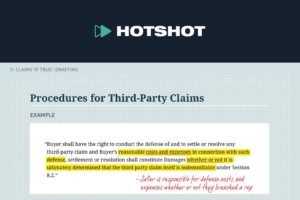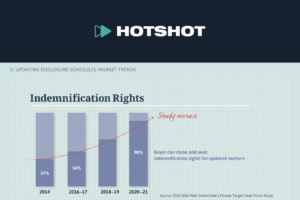Sometimes a plan doesn’t work out quite how you expected – and you still end up giving your learners exactly what they need.
That’s what happened for Craig Menden and his colleagues at Willkie Farr & Gallagher when they put together a remote training program for associates. The pandemic had paused in-person training. So, Menden, who is co-chair of the firm’s Technology Transactions Group, wanted to offer an engaging virtual training program. “The associates were concerned they weren’t getting the same training they would if they were in the office,” Menden says.
Come as you are
“We wanted to cover a lot of ground when we were all together on a call, so we assigned Hotshot videos as prework,” Menden explains. “The videos are a quick and engaging way for associates get up to speed before the session.” The plan was for the presenters to build on the prework with “war stories” and the firm’s specific approach to the issues.

Craig Menden, partner at Willkie Farr & Gallagher.
But the remote training programs for associates were scheduled when the firm was also breaking records for monthly billable hours. “Everyone was so busy that very few had time to watch them ahead of time,” Menden says. Registrations were strong, but Menden and his colleagues were afraid they would lose people who felt awkward coming to a session they hadn’t prepared for. “We had to change the way we presented it,” he says.
Rather than assuming everyone was coming in with a baseline of knowledge and then digging into the nuances, the presenters showed portions of the videos during the session and then had those discussions. In an hour-long session, they could cover two topics, with each topic including ten minute of video introduction and 20 minutes of discussion led by three partners of different experience levels.
Even though the pivot meant they could cover only two topics per session—instead of three—the tradeoff was worth it. “We were able to reach far more people without sacrificing the intent of the program,” Menden says.
Training overview
- Length: One hour
- Topic: The session covered two advanced M&A topics: materiality scrapes and indemnifiable losses
- Format: Zoom call that featured snippets of video content and a panel of partners discussing the issues
- Audience: All corporate associates and partners were invited, with messaging that it would be most relevant to mid-level and senior associates. There were participants at all experience levels.
- Preparation: Menden says he spent about a couple of hours preparing for each session – selecting video clips and making outlines for the other presenters. The other panelists spent about an hour, including attending a short pre-call and compiling their own war stories to share. “The resources from Hotshot made it easy to reduce prep time,” he says.
Putting the learning to work
Menden knows that these remote training programs for associates don’t close the gap on the coaching and development that associates are asking for, but they do help. “The thing that gets missed when you’re not in person is the informal debrief after a call or meeting,” he says. “In person, partners will answer questions and explain why things went the way they did. When you’re remote, no one picks up the phone to debrief. When the associate does call it’s about a specific question, and it’s brief.”
Although it’s not delivered exactly at the point of need like that, Menden says the content in the videos is as good or better than some of that informal learning. “It’s a succinct and well-thought-out version of the teaching we try to do in the moment,” he says.
Associates at Willkie agree. “The training sessions are a helpful avenue for learning to be a skilled attorney,” says Robert Yu, an associate at the firm. Yu went on to say, “I find having a framework that explains a legal concept supplemented by real-life anecdotes of how such concepts are applied to be very effective. Trainees can quickly identify the parts of the training that has the most relevance and also make important indirect connections to other legal concepts. Often a war story will contain additional information and context around why and how the legal concept was used, which makes the concept easier to understand and more digestible.”
Looking ahead
Willkie’s offices have reopened, and many people are choosing to work onsite. Partners are in the office three days a week. “We encourage people to come in when we’re here, so associates can sit in on calls and take up that informal learning again,” Menden says. Even now though, he still uses other Hotshot videos to provide context for some of his responses to on-the-fly questions from associates.
“Frequently someone asks me a question about something that is covered in a video,” he says. “I give them a short answer and then send them to the video. Every time I’ve done that they come back and say ‘Wow, I learned so much from that video. I can’t believe that I have been practicing all these years and didn’t know that.”
As for more formal learning programs, Menden says that given how many offices the firm has, the video and hybrid approaches are here to stay. As the PD team continues to offer monthly learning opportunities, Menden hopes he and the other partners will offer up similar content to engage associates and help them develop.
Meanwhile, Yu and his colleagues are all working to find the right mix of in-person and remote work that suits them. Yu offers this advice to other associates faced with a choice: “It is important to have a sense of what type of professional you are and what environment is most effective for you. If you are the type of associate who needs face time to learn concepts, make an effort to come into the office to try to catch partners or senior associates for informal mentoring moments.” On the other hand, “If you are fully comfortable working remote, don’t be afraid to pick up the phone to ask questions about a legal concept. I have found that folks in this industry very much value attentiveness and a desire to learn, and they are always willing to mentor and nurture those who express those values.”
Partners and PD partnering
While Menden brought this idea to his Professional Development (PD) colleagues, he believes that PD teams at other firms could easily sell the idea to their partners. “The Hotshot videos we used were presented by partners who are considered leaders in corporate law,” Menden says. “If you share those videos and let them know they can simply tell their stories – rather than having to formally instruct – it should be an easy sell.”
Using video for the formal instruction helps focus the session on exactly what participants need to know – rather than them having to rely on getting it from partners in small pieces over the course of many post-negotiation debriefs. “The videos are a much more focused download,” Menden says. “Otherwise, it might take multiple calls with multiple partners to get what they need to be effective. And focusing on specific stories and examples is more enjoyable for the presenters as well.”
Menden intends to offer similar sessions again soon. This time around, he’ll go into it knowing that a mix of video and discussion helps keep everyone on the same page and relieves the pressure of having to do prework before showing up. “We don’t want to scare anyone off,” Menden says. “Most of a lawyer’s learning is done in the moment anyway – it makes total sense to approach this in the same way.”
Hotshot can work with your firm to implement a remote training program for associates. We can also brainstorm other ways to engage and educate your associates. Contact us to learn more or check out our topics, learning tracks, and training guides.

















